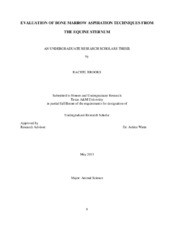| dc.description.abstract | ABSTRACT
Evaluation of bone marrow aspiration techniques from the equine sternum (May 2013)
Rachel Brooks
Department of
Animal Science
Texas A&M University
Research Professor: Dr. Ashlee E. Watts
Department of
Large Animal Clinical Sciences
There are many methods employed in the aspiration of bone marrow in equine. The two common aspiration sites include the ileum and the sternum. The location used in this study was the equine sternum, where 60mls were withdrawn using two different methods in four syringes. In the first two syringes, the needle is inserted and 60mls are aspirated without advancements. The second two aspirations are made with an advancement of the needle after every 15 mls of mesenchymal stem cell recovery.
Because the first 5mls extracted from the aspiration site usually yield the highest number of viable mesenchymal stem cells, it is theorized that the second method of aspiration will yield a higher number of stem cells that are also more viable. After aspiration, certain protocols were used to determine which syringe recovered these cells. An initial cell count was performed on a 2ml sample of the syringe. The remaining 5 ml sample was plated and fed with fetal bovine serum every 72 hours for 10 days. At the end of this time, the cells were stained using crystal violet and photographed. This made cell colony growth visible and measurable.
The first four samples were plated and fed for 14 days. These plates ended up with colonies that were too dense and uncountable. The next two samples were plated for 10 days, and this yielded desirable colony formation. In preparation for staining the final two horses, I mistakenly washed the cells with ethanol instead of methanol. This destroyed the colonies and yielded no results.
While there were no statistically significant conclusions to be drawn in the study, there are strong trends supporting the theory that multiple advancements of the needle during aspiration yield higher numbers of more viable stem cells. Harvesting stem cells optimally translates to higher success in treatment of joint and tendon injuries.
Citations
KASASHIMA, Y., UENO, T., TOMITA, A., GOODSHIP, A. E. and SMITH, R. K. W. (2011), Optimisation of bone marrow aspiration from the equine sternum for the safe recovery of mesenchymal stem cells. Equine Veterinary Journal, 43: 288–294. doi: 10.1111/j.2042-3306.2010.00215.x
Can J Vet Res. 2012 Jan;76(1):52-6.
Comparison of bone marrow aspiration at the sternum and the tuber coxae in middle-aged horses.
Delling U, Lindner K, Ribitsch I, Jülke H, Brehm W.
Large Animal Clinic for Surgery, Faculty of Veterinary Medicine, University of Leipzig, An den Tierkliniken 21, 04103 Leipzig, Germany. delling@vetmed.uni-leipzig.de | en |


